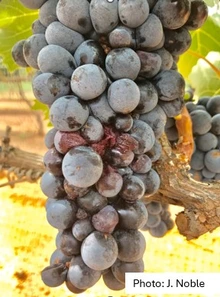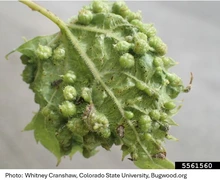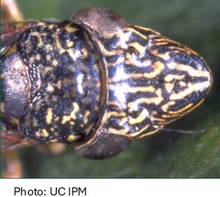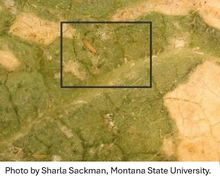Guide
Publication Date: July 2024
Jump To:
- What is Scouting and Why Should We Scout?
- Crown Gall
- Grape Powdery Mildew
- Phomopsis Cane and Leaf Blight
- Sour Rot Complex
- Botrytis Bunch Rot
- Viruses
- Trunk Disease Complex
- Pierce’s Disease
- Cutworms
- Hornworm Caterpillars
- Phylloxera
- Glassy-Winged Sharpshooter
- Thrips
- Leafhoppers
- Grapeleaf Skeletonizer
- Fruit Flies
What is Scouting and Why Should We Scout?
Scouting is deliberately moving through the vineyard with the purpose of searching for pests, weeds, and pathogens.
Must understand biology of vineyard:
- Pest/beneficial/symptom ID
- Pest development stages
- Weed cycles
- Disease triangle
Must understand abiotics:
- How weather affects
- How soils affect growth
- How vineyard geography effects pest population
- “Hot spots”
Why?
- Stop problems before they are uncontrollable, or populations become large enough to show resistance
Crown Gall
- What: Agrobacterium vitis bacteria
- Why: Infects vines (usually in nursery), causing gall growth/vascular disruption
- Where to Scout: Galls often form a base of trunk and leaves above are often red. Look in low-lying areas
- When to scout: Summer
- Signs/Symptoms: Creamy-white, eventually brown desiccated galls noticeable in summer. Foliar symptoms often appear in summer
- IPM: Site selection, retraining, buy clean plants, multiple trunks, hot water treatment of cuttings
Grape Powdery Mildew
- What: Erysiphe necator Fungus
- Why: Without fungicides, PM would be the most destructive grape disease worldwide
- Where to Scout: Colonies establish on young, fresh growth. Infections usual found in shady, cool areas of canopy. Look on morning sides and areas of congestion
- When to Scout: Visible symptoms may appear 7 to 10 days after “infection event” (.1” wetness, avg temp of 50F)
- Signs/Symptoms: Silvery white fungal infections with a “sheen” on fruit and foliage often close to cordon
- IPM: Shoot thinning and morning-side leaf removal, FRAC group rotation, water management, preventative fungicide applications
Phomopsis Cane and Leaf Blight
- What: Phomopsis viticola fungus
- Why: Rainy weather during early growing season favors development; severe infections cause brittle rachis and cane, crop loss, and leaf damage
- Where to Scout: Shady, congested areas in the vineyard
- When: Fruit symptoms appear 3 weeks before harvest, in leaves at senescence
- Signs/Symptoms: Rough, black lesions on shoots, leaves, and rachises are most common. Leaves may also be light green, turning black with yellow margins
- IPM: Canopy and water management, especially during wet years. Remove infected canes during pruning, cane prune. Spray at 1-3” using M-series fungicides
Photos: University of Georgia Plant Pathology , University of Georgia, Bugwood.org
Sour Rot Complex
- What: Ethanol-producing yeast and acetic acid-producing bacteria which is vectored by fruit flies (Drosophila spp)
- Why: Damaged fruit becomes infected by yeast and acetobacter, which produce acetic acid, rots fruit and raises VA of juice
- Where to scout: Congested areas, smell of vinegar
- When: a few weeks before harvest, 12 to 13 brix
- Signs/Symptoms: Pink-brown discoloration of berry skins and loss of integrity. Strong smell of vinegar and presence of fruit flies
- IPM: Deficit irrigation to loosen clusters, shoot-thinning and leafing, responsible cropping, control of fruit flies, anti-microbials
Botrytis Bunch Rot
- What: Botrytis cinerea fungus
- Why: Fungus colonizes dead/dying fruit/flower tissue, rotting away fruit
- Where: Compact fruit clusters, especially in congested areas of vineyard
- When to scout: Post veraison, when RH is high and temperatures are relatively cool
- Signs/Symptoms: Fuzzy grey fungal growth. Berries turn pink/brown, eventually drying out
- IPM: Loose-clustered varieties, RDI, botryticides bloom to bunch-closure, open canopies up, remove clusters touching others
Viruses
- What: Grapevine Leafroll and Redblotch disease-causing viruses
- Why: Viruses cause reduced vigor, poor color, slowed ripening/low sugar
- Where: Symptoms usually start near the center of the cordon
- When to scout: Post-veraison through fall
- Signs/Symptoms: Interveinal/blotchy reddening of leaves in red cultivars, chlorotic in white. Rolled leaves in leafroll.
- IPM: Clean plants, vector (3-cornered alfalfa hopper and mealybug) control, rogue and replant if populations are low, good nutrient program to rule out deficiency, testing, low cropping
Trunk Disease Complex
- What: Range of wood-decaying fungi (Cytospera, Botryspheria, Eutypa, Esca)
- Why: Infections cause wood dieback of spurs, arms, trunks
- Where: Typically in older vines
- When: From budbreak until leaf fall
- Signs/Symptoms: Weak canopy growth, decreased yield, dark coloration of wood, sometimes in wedge shape
- IPM: Pre-pruning, fungicides on pruning wounds, cordon/trunk renewal, pruning during dry periods
Pierce’s Disease
- hat: Xylella fastidiosa bacterium
- Why: Blockage of xylem causes vine collapse
- Where: Near riparian areas, throughout vineyard
- When: Symptoms often begin in mid to late summer through senescence
- Signs/Symptoms: Burnt leaf margins similar to drought stress, “matchstick” petioles remain on vine after leaf fall, cane periderm forms in a patchy pattern, delayed bud break, newly set fruit dries up
- IPM: Resistant cultivars, vector (sharpshooter) control, bacteriophage virus treatment?? (https://inphatec.com/xylphi_pd)
Cutworms
- What: Various species of moth caterpillar
- Why: Climb up vines in spring and eat opening buds
- Where: Buds along the cordon/cane
- When to scout: Spring, when buds are between the dormant and expanded leaf stages. Damage usually occurs in aggregated “hotspots”
- Signs/Symptoms: Larvae are rarely seen, more often you find the damaged buds
- IPM: Allow weeds to grow early in spring, use pyrethroid barrier spray, leave extra buds, scout regularly
Hornworm Caterpillars
- What: Various species of sphinx moth caterpillar
- Why: Feed on grapevine leaves, which can be hard on young vineyards
- Where: Caterpillars in canopy, pupae in soil
- When to scout: Adults lay eggs in spring, which hatch in 3 to 4 weeks. 2 generations
- IPM: Not generally a threat in established vineyards, so no action necessary, Bt useful, insect growth regulators also used, parasitism common
Image

Phylloxera
- What: Daktulospharia vitifoliae insect
- Why: Insect feeds on roots, causing stunting, and eventually death
- Where: Primarily in soil, where weak areas of the vineyard are growing in circular pattern. Sample periphery of circle, not center. Sampe 1.5ft radius from vine, down to 4ft
- When: Late summer/Early fall when populations are highest
- Signs/Symptoms: Weak, stunted growth and nodules/galls on roots and rarely leaves. Insects are small and often yellow
- IPM: Rootstocks, selected systemic insecticides, site selection (sandy soils)
Glassy-Winged Sharpshooter
- What: Homalodisca vitripennis insect
- Why: Vector of Xylella fasitidiosa
- Where: Tips of new shoots, look for liquid associated with feeding
- When: Use sticky traps (no pheromone) from budbreak to leaf-fall
- Signs/Symptoms: Large (0.5”) cycada-like insect, clear wings with red veination, head brown to black with ivory spots
- IPM: Site selection, parasitoid release?, insecticide, trap monitoring
Thrips
- What: Thrips (Thysanoptera) insects
- Why: Can stunt new, growing foliage, especially in a wet winter/spring
- Where: On foliage and fruit. Hold a piece of paper underneath and tap foliage
- When to scout: Early spring, as shoots are emerging
- Signs/Symptoms: Cupping of leaves, scaring, and “halo-spotting” of fruit; insects are very small, though can be seen with naked eye
- IPM: Only mow every other row in a session, push water and nutrients to “push through”, insecticide
Leafhoppers
- What: Erythroneura spp. Insect
- Why: Adults and nymphs suck chlorophyll and nutrients out of leaf cells. Damage could cause delay in ripening if severe and early, or sunburn fruit if canopy thinned enough
- Where: Shaded canopy leaves
- When to Scout: Starting in spring
- Signs/Symptoms: Stippling effect on leaves, turning entire leaf yellow, molts of insects, insects “hopping” readily as you move through canopy
- IPM: Canopy/water/fertilizer management, (hairy-leafed) variety selection, Surround clay, neonicitinoids, pyrethrins. Accepted threshold=15 insects per leaf after collecting 10 leaves randomly through vineyard
Grapeleaf Skeletonizer
- What: Harrisina metallica insect
- Why: Larvae feed on lower leaf surface, resulting in a “skeletonized” effect of defoliation, which could also lead to sunburn
- Where: Throughout canopy
- When: Late spring forward
- Signs/Symptoms: Skeletonized leaves, barrel shaped eggs laid on lower leaves
- IPM: Bacillus thurengiensis, Spinosad, natural enemies, Granulosis virus
Fruit Flies
- What: Drosophila spp. insect
- Why: Insects lay eggs in damaged fruit and vector microorganisms that cause sour rot
- Where: Throughout vineyard where berries are damaged, can trap with yeast or apple cider vinegar
- When: Post veraison through harvest
- Signs/Symptoms: Vinegar smell in vineyard, rotting fruit, swarming small fruit flies
- IPM: Variety selection, water management for cluster morphology, Spinosad chemistry
Image







































